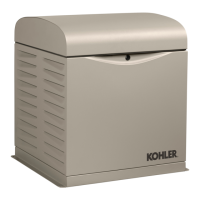TP-6881 7/15 55Section 4 Troubleshooting
Section 4 Troubleshooting
4.1 Introduction
Corrective action and testing in many cases requires
knowledge of electrical systems and electronic circuits.
Testing and service must be performed by an authorized
distributor/dealer or trained service technician.
Refer to the engine service manual for engine service
information. See the List of Related Materials for the
document part number.
If the troubleshooting procedures in this section identify
a failed part, refer to the parts catalog for replacement
part numbers. See the List of Related Materials in the
Introduction for the parts catalog number.
4.2 Theory of Operation,
Electronic Start Sequence
The following steps trace the electronic system as
different leads and components are energized during
the start sequence. A start signal can come from any of
the following:
D Pressing the Run button on the RDC2 or DC2
controller
D A remote start signal through RBUS (from an RXT
transfer switch, for example)
D Closing a contact across engine start connections 3
and 4 (remote start/stop switch or non-RBUS transfer
switch engine start signal)
D A start signal over Ethernet from OnCue Plus
The start signal begins the series of events that adds
fuel, ignition, and engine crank to the start sequence.
Use the steps below and refer to the wiring schematics
in Section 7 to assist with troubleshooting and checking
for loose connections or damaged leads.
1. Engine Crank
a. When the start signal is received, the RDC2 or
DC2 controller energizes FP and lead 71.
b. FP provides battery flashing to the rotor field.
c. Lead 71 energizes the starter relay, P10 or
crank relay on the schematic.
d. The starter relay closes the starter relay
contact which energizes the start solenoid.
e. The start solenoid closes and energizes the
starter motor, which cranks (turns) the engine.
f. The engine rotation along with field excitation
produces alternator voltage.
2. Fuel and Ignition
a. When cranking is initiated, the RDC2/DC2
controller will begin to monitor output voltage
amplitude (L1--L2) and auxiliary winding
frequency (55--66).
b. When the RDC2/DC2 controller detects
acceptable v oltage (L1--L2) or frequency
(55--66), the RDC2/DC2 controller energizes
wire 70, removes the ground to the ignition
module.
(1) If acceptable voltage or frequency is not
detected within 3 seconds, the cranking
cycle will terminate and a crank pause will
begin.
c. Lead 70 energizes run relay P11, energizing
the fuel valve to allow fuel to flow to the
carburetor and energizing the ignition,
producing ignition spark.
d. When the RDC2 controller senses alternator
voltage or frequency, the RDC2 controller also
energizes and governs the stepper motor
through leads 1A, 1B, 2A, and 2B.
e. The stepper motor actuates the throttle arm on
the carburetor allowing fuel to enter the engine.
f. The RDC2/DC2 controller senses speed
based on voltage buildup in windings 55 and
66. When the controller senses that the engine
has reached 1000 RPM for the 8 RESV or 750
RPM for the 10/12RESV, the RDC2/DC2
controller will drop power to lead 71, ending the
start sequence.
g. If running speed is not achieved within 15
seconds, the cranking cycle will terminate and
a crank pause will begin.
h. If successful starting is not achieved after 3
cranking cycles, an OverCrank fault will occur.

